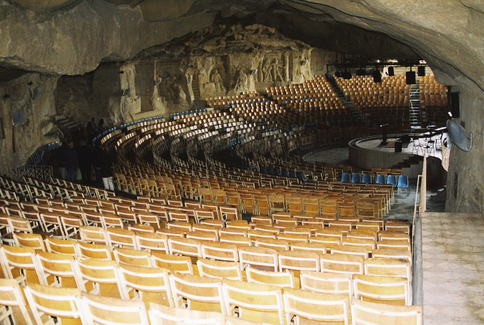RFI’s Paul Marshall authored an essay published recently in Religion Unplugged on how the ‘Cave Church’ located in Cairo, Egypt is a “Sign of Hope in the Middle East.” “Amid the pain and suffering in the Middle East, it is good to be reminded that beautiful things also happen there,” Marshall writes. He continues:

One such remembrance came on Oct. 11 with the funeral of Father Simaan Ibrahim in Muqattam, in southeast Cairo. It was a funeral, with much lament, but also a joyous occasion that drew 30,000 people to worship in the monastery of St. Simaan the Tanner church, which he had founded and led for 50 years.
These many tens of thousands were able to gather inside a myriad of caves at the base of the cliffs of Muqattam. In congregation, setting and architecture, it is one of the most remarkable churches in the world.
Down a narrow lane from the cave lies one of the poorest areas of Cairo. It is colloquially known as “Garbage City” and is the home of the zabaleen, the garbage collectors.
Most of the garbage collection in Cairo has been done privately, usually by Christians, Copts who make up the vast majority of the zabaleen. They pick the garbage up in trucks and carts, take it back to where they live and sort through it for anything possibly valuable — tires, plastic, cloth, cardboard — which they then try to sell for recycling. They live amid the garbage, much of which is deemed religiously unclean, and so those who collect it are also seen as unclean.
Read the full article: “The ‘Cave Church’ A Sign Of Hope In The Middle East.”
THE RFI BLOG

Does Southeast Asia Lead the World in Human Flourishing?

RFI Leads Training Session on Religious Freedom Law and Policy for U.S. Army War College

Oral Argument in Charter School Case Highlights Unconstitutional Motives Behind OK Attorney General’s Establishment Clause Claim

Largest Longitudinal Study of Human Flourishing Ever Shows Religion’s Importance

Keys To Human Flourishing: Faith And Relationships Outweigh Wealth
CORNERSTONE FORUM

Reaffirming Religious Freedom: Bridging U.S. Advocacy and Iraq’s Constitutional Framework

Political Polarization, Same-Sex Marriage and Religious Liberty

Bridging the Gap Between International Efforts and Local Realities: Advancing Religious Freedom in the MENA Region

Challenges to Religious Freedom in Iraq and the Critical Need for Action

